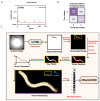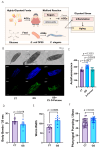WormCNN-Assisted Establishment and Analysis of Glycation Stress Models in C. elegans: Insights into Disease and Healthy Aging
- PMID: 39273622
- PMCID: PMC11395114
- DOI: 10.3390/ijms25179675
WormCNN-Assisted Establishment and Analysis of Glycation Stress Models in C. elegans: Insights into Disease and Healthy Aging
Abstract
Glycation Stress (GS), induced by advanced glycation end-products (AGEs), significantly impacts aging processes. This study introduces a new model of GS of Caenorhabditis elegans by feeding them Escherichia coli OP50 cultured in a glucose-enriched medium, which better simulates human dietary glycation compared to previous single protein-glucose cross-linking methods. Utilizing WormCNN, a deep learning model, we assessed the health status and calculated the Healthy Aging Index (HAI) of worms with or without GS. Our results demonstrated accelerated aging in the GS group, evidenced by increased autofluorescence and altered gene expression of key aging regulators, daf-2 and daf-16. Additionally, we observed elevated pharyngeal pumping rates in AGEs-fed worms, suggesting an addictive response similar to human dietary patterns. This study highlights the profound effects of GS on worm aging and underscores the critical role of computer vision in accurately assessing health status and aiding in the establishment of disease models. The findings provide insights into glycation-induced aging and offer a comprehensive approach to studying the effects of dietary glycation on aging processes.
Keywords: C. elegans; Convolutional Neural Networks; Glycation Stress; aging; computer vision.
Conflict of interest statement
The authors declare no conflicts of interest.
Figures






Similar articles
-
Rifampicin reduces advanced glycation end products and activates DAF-16 to increase lifespan in Caenorhabditis elegans.Aging Cell. 2015 Jun;14(3):463-73. doi: 10.1111/acel.12327. Epub 2015 Feb 26. Aging Cell. 2015. PMID: 25720500 Free PMC article.
-
DAF-16 stabilizes the aging transcriptome and is activated in mid-aged Caenorhabditis elegans to cope with internal stress.Aging Cell. 2019 Jun;18(3):e12896. doi: 10.1111/acel.12896. Epub 2019 Feb 17. Aging Cell. 2019. PMID: 30773782 Free PMC article.
-
Piceatannol extends the lifespan of Caenorhabditis elegans via DAF-16.Biofactors. 2017 May 6;43(3):379-387. doi: 10.1002/biof.1346. Epub 2017 Jan 27. Biofactors. 2017. PMID: 28128482
-
EGF signaling comes of age: promotion of healthy aging in C. elegans.Exp Gerontol. 2011 Feb-Mar;46(2-3):129-34. doi: 10.1016/j.exger.2010.10.010. Epub 2010 Nov 11. Exp Gerontol. 2011. PMID: 21074601 Free PMC article. Review.
-
DAF-16/FoxO in Caenorhabditis elegans and Its Role in Metabolic Remodeling.Cells. 2020 Jan 2;9(1):109. doi: 10.3390/cells9010109. Cells. 2020. PMID: 31906434 Free PMC article. Review.
Cited by
-
L-Theanine Extends the Lifespan of Caenorhabditis elegans by Reducing the End Products of Advanced Glycosylation.Foods. 2025 Jan 13;14(2):221. doi: 10.3390/foods14020221. Foods. 2025. PMID: 39856887 Free PMC article.
-
ElixirSeeker: A Machine Learning Framework Utilizing Fusion Molecular Fingerprints for the Discovery of Lifespan-Extending Compounds.Aging Cell. 2025 Aug;24(8):e70116. doi: 10.1111/acel.70116. Epub 2025 May 26. Aging Cell. 2025. PMID: 40419453 Free PMC article.
-
Advanced Glycation End-Product-Modified Heat Shock Protein 90 May Be Associated with Urinary Stones.Diseases. 2025 Jan 2;13(1):7. doi: 10.3390/diseases13010007. Diseases. 2025. PMID: 39851471 Free PMC article.
References
-
- Lan J., Huang X., Li H., Lin S., Huang J., Yang W., Ouyang M., Fang J., Xu Q. YTHDF2 Regulates Advanced Glycation End Products-Induced Melanogenesis through Inhibiting A20 Expression in Human Dermal Fibroblasts. [(accessed on 23 July 2024)]; Available online: https://pubmed.ncbi.nlm.nih.gov/39009810/ - PubMed
-
- Awan U.N., Waraich R.S., Nangrejo R., Noor S.S., Siddiqui I.A., Ikram K. RAGE Signalling Contributes to Oxidative Stress and Inflammation in Knee Osteoarthritis Patients with Metabolic Syndrome. [(accessed on 23 July 2024)]; Available online: https://pubmed.ncbi.nlm.nih.gov/39008290/ - PubMed
MeSH terms
Substances
Grants and funding
LinkOut - more resources
Full Text Sources
Miscellaneous

